New Discoveries
 Welcome to the New Discoveries blog! City of San Diego City Clerk Archives staff use this area to upload newly rediscovered documents from San Diego’s history. In their duties, staff often find unique and interesting pieces of history they want to bring to the public. Those documents are uploaded here and then organized into their appropriate Collection, or a new Collection is created. Please check back frequently for fascinating new finds and discoveries!
Welcome to the New Discoveries blog! City of San Diego City Clerk Archives staff use this area to upload newly rediscovered documents from San Diego’s history. In their duties, staff often find unique and interesting pieces of history they want to bring to the public. Those documents are uploaded here and then organized into their appropriate Collection, or a new Collection is created. Please check back frequently for fascinating new finds and discoveries!
Published on
November 27, 1918 - Celebration Flight
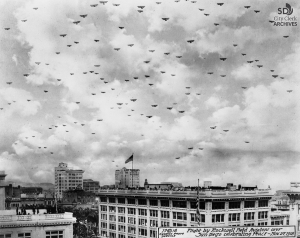
Download Image
Take a look at this awesome picture of aviators from Rockwell Field flying over downtown San Diego to celebrate the end of World War I in November 1918. The Rockwell Field was located on North Island in San Diego, California, which was originally called the Signal Corps Aviation School. It was the first U.S. Army school to provide flying training for military pilots, and North Island was the school's first permanent location. The Aviation School was officially established on North Island in 1912.
Published on
May 23, 1889 - Multitasking Pays Off
According to this interesting ordinance the Common Council and Board of Alderman appointed W. H. Rapier the first Janitor and Sergeant of Arms during the session of the Common Council. Mr. W. H. Rapier’s monthly compensation wage was $55.00.
Published on
1916 - Cadillac Motor Car Ambulance

Download Image
Please look at this well-designed ambulance in 1916. This classy ambulance was created and built for excellent and easy riding for patients. This ambulance was very popular and showcased in the east coast.
Published on
1938 -1939 – San Diego Yearbook
If you are in school, you will get yearbook every year. Have you ever seen the 1938 San Diego Yearbook? It's actually the City Manager's annual report, and it's pretty fascinating. It goes into detail about the municipal operations during the fiscal year from July 1, 1938, to June 30, 1939. It's filled with lots of interesting data and photos showing how tax dollars were used. Why not give it a read? It's a pretty neat insight into our city's history!
Published on
August 11, 1890 – Petition from the Ladies Annex
Please take a moment to review this elegantly written petition drafted in 1890 by the Ladies Chapter of the San Diego Chamber of Commerce. The petition proposed the implementation of an ordinance requiring vendors to change from house-to-house produce sales to selling their goods in the market square.
Published on
1916 – Concert on the Lawn
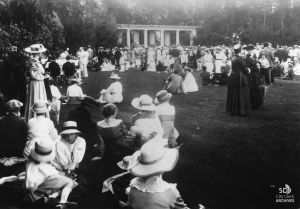
Download Image
Check out this charming 1916 photo of beautifully dressed ladies and gentlemen eagerly waiting on the lawn to attend a concert during the Panama California Exposition! It's such a timeless and elegant scene. The Panama California Exposition held at Balboa Park in San Diego between January 1, 1915, and January 1, 1917. The exposition celebrated the opening of the Panama Canal and was meant to tout San Diego as the first U.S. port of call for ships traveling north after passing westward through the canal.
Published on
Undated – William Tomkins' handshake with Sioux Native American Chief Crow Eagle
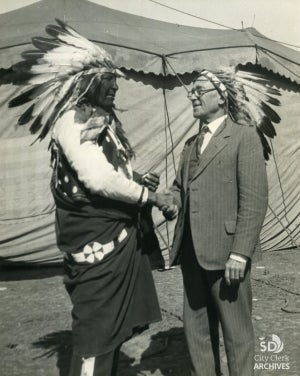
Download Image
View the image of William Tomkins, shaking hands with Sioux Native American Chief Crow Eagle. Tomkins served as Secretary of the San Diego Chamber of Commerce from 1913-1915 and again from 1917-1921. He was also an expert in the study of Indian sign language.
In 1926, William Tomkins’ self-published the “Universal Indian Sign Language of the Plains Indians of North America,” followed by "A Culture Attainment of the First American- Universal Indian Sign Language.”
Published on
December 6, 1959 – The Second Annual Leatherneck Bowl Game
Check out this resolution from 1959 about the Second Annual Leatherneck Bowl Game! It took place at Balboa Stadium on December 6, 1959, between the football teams from Bolling Air Force Base and San Diego Marine Corps Recruit Depot. They played to raise funds for Navy Relief and the United Fund. Such a fun way to support a great cause!
Published on
May 18, 1937 - Petition for Dance Hall License
This petition, dated 1937, is requesting a dance hall license to conduct dances on the ground floor of the Cafe of the World's Building in Balboa Park. The applicants are Robert O. Peterson & Frank J. Losey. Robert Oscar Peterson (1916-1994) was the founder of the Jack in the Box restaurant. In 1941, he kicked off his restaurant business and in 1951, he opened the first Jack in the Box restaurant on El Cajon Boulevard. He's known for pioneering the drive-through window with an intercom system.
Published on
April 18, 1989 - Cesar Chavez Day
In this 1989 resolution, the City Council declared April 18, 1989, as "CESAR CHAVEZ DAY" to honor this remarkable labor leader and civil rights activist. Cesario Estrada Chavez (March 31, 1927-April 23, 1993)
Published on
1912 - A Gateway to the East
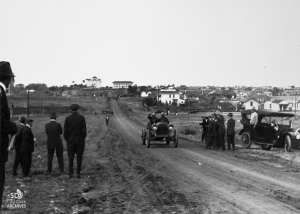
Download Image
Checkout this auto racing on El Cajon Boulevard looking west toward Park Boulevard in 1912. Possibly, this was the annual two-day road race from Los Angeles to Phoenix by way of San Diego that began in 1911. It was established to advertise San Diego as a gateway to the East. The first driver arriving from Los Angeles won a $1,000 prize. Spectators enjoyed the annual event for several years.
Published on
July 5, 1927 - The Soul of the American Indian
Please review a resolution from 1927 authorizing Leroy Keleher a free license to sell the book, "The Soul of the American Indian," from house to house. Mr. Keleher is the author of this book, which explores the spiritual beliefs and traditions of Native American tribes.
Published on
1973 - Bathtub Racing on the Bay
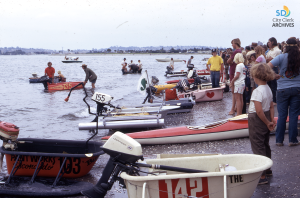
Download Image
Take a look at this photo of participants preparing to launch in the 1973 Bathtub Races in Mission Bay. The races were held at Crown Point Shores as part of activities celebrating San Diego's America's Finest City Week, August 24-31, 1973. The boats are small watercraft designed around bathtubs or close facsimiles. The rules restrict the engine to 8 horsepower and the weight to a minimum of 350 pounds including the driver.
Published on
1970 - The Site of the First National Bank
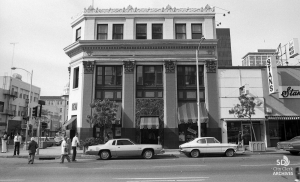
Download Image
The location at 904 Fifth Avenue was the site of the First National Bank Building in the 1880s. The original bank was built in 1884, later demolished and replaced with this building. In the 1970s, it was the Far East Trading Company. Restored during the Gaslamp Quarter preservation, it is now the site of a restaurant at the corner of Fifth and E Street.
Published on
March 20, 1911 - Forty Acres of Land Prospected for Petroleum
On March 20, 1911, Ordinance 4404 was passed by the Common Council to authorize the lease of 40 acres of Pueblo Lands, located north line of the San Diego River, to be prospected for petroleum. And it was submitted to the electors of the city for approval on April 4, 1911. Today’s terminology would call this “Liquid Gold.”
Published on
November 29, 1937 – Fundraising for Women and Children During the War
This petition proposed by the Chinese Relief Committee of the American Red Cross in 1937 aimed to fundraise by selling flowers on the streets to relieve the women and children of China under the distress of war. The next day, the Council approved this petition in Resolution No.66887. On July 7, 1937, the Marco Polo Bridge incident occurred, marking the beginning of Japan's comprehensive military campaign in China. The Marco Polo Bridge incident is generally regarded as the start of the Second Sino-Japanese War, and the Pacific theatre of World War II.
Published on
1887 - City Waterfront

Download Image
The image was taken by Herve Friend, for Douglas Gunn's book 'Picturesque San Diego,' published in 1887. Elisha Babcock and Hampton Story were the founders of the Hotel del Coronado. They built an extensive wharf and a slip for their ferry boat Coronado in 1886 in the harbor to handle the increase in commerce, but it was blamed for restricting free and safe navigation. A lawsuit was brought against Babcock and Story under state law for obstructing navigation, resulting in a verdict and $100 fine.
Published on
1943 – 73 Years of Achievement
Please review this promotional page from 1943, created by the San Diego Chamber of Commerce to celebrate its 73rd anniversary. The San Diego Chamber of Commerce was established in 1870 by Alonzo Horton, a well-known local entrepreneur who served as the chamber's first treasurer. The chamber initially worked to develop railway infrastructure, support harbor commerce, and encourage settlement and tourism in San Diego. In the early 20th century, it played a significant role in establishing military installations. This had a huge positive impact on the local economy. Let's not forget about the 1915 Panama-California Exposition! The chamber was the driving force behind that incredible event, which put San Diego on the map.
Published on
January 23, 1974 - Chinese New Year Observance Day
Did you know that back in 1974, Mayor Pete Wilson declared January 23rd as "Chinese New Year Observance Day?” It was also to celebrate the Chinese New Year, Year of the Tiger! Speaking of Chinese New Year, the celebration begins on February 10, 2024. It's the Year of the Dragon! This holiday is super important in Chinese culture and is celebrated not only in East Asia and Southeast Asia, but also in other places like Australia, Canada, and the United Kingdom. It's truly a worldwide celebration!
Published on
November 12, 1925 – The Sisters of Nazareth’s Invitation
Please review this 1925 invitation from the Sisters of Nazareth for the dedication ceremony of the orphanage on November 15, 1925. The Sisters of Nazareth have a longstanding history, dating back to 1851. Its first presence in America was in 1924, in San Diego.

